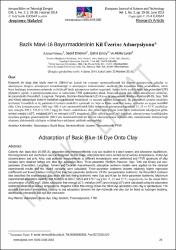Bazik mavi-16 boyarmaddesinin kil üzerine adsorpsiyonu
Abstract
Katyonik bir boya olan bazik mavi-16 (BB16)’nın kesikli bir sistemde montmorillonitik kil üzerine adsorpsiyonu çalışıldı ve
adsorpsiyon dengesi, adsorpsiyon termodinamiği ve adsorpsiyon mekanizmaları incelendi. Bu kapsamda farklı sıcaklıklarda, farklı
boya başlangıç konsantrasyonlarında ve farklı pH’larda adsorpsiyon testleri uygulandı. Ayrıca farklı sıcaklıklarda zeta potan siyel (ZP)
ölçümleri yapıldı ve adsorpsiyondan önce ve sonra kilin FTIR spektrumları alındı. Deneysel olarak elde edilen adsorpsiyon verilerine,
iki parametreli (Freundlich, Langmuir, Tempkin, Dubinin-Radushkevich (D-R)) ve üç parametreli (Redlich-Peterson(R-D), Sips, Toth
and Khan) adsorpsiyon izoterm modelleri uygulanarak modellendi ve izoterm sabitleri hesaplandı. İki parametreli izoterm modelleri
içerisinde Freundlich ve üç parametreli izoterm modelleri içerisinde ise Sips ve Khan modelleri deney verilerine en uygun mod eller
oldu. Giriş konsantrasyonu 1400 mg/l BB16 için montmorillonitik kilin maksimum adsorplama kapasitesi 15, 25 ve 35 ºC sıcaklıklar
için sırasıyla 509,7, 525,0 ve 570,7 mg/g’dır. Farklı sıcaklıklarda elde edilen adsorpsiyon izotermleri kullanılarak adsorpsiyon gibbs
serbest enerjisi (G
o
), entalpisi(H
o
) ve entropisi (S
o
) hesaplandı. Elde edilen negatif G değerleri, adsorpsiyonun kendiliğinden
meydana geldiğini göstermektedir. BB16’nın montmorillonitik kil üzerine adsorpsiyonunu sağlayan olası mekanizmalar hidrojen b ağı
oluşumu, elektrostatik etkileşim ve boya-boya etkileşimi şeklinde sıralanabilir. Cationic dye, basic blue 16 (BB16), adsorption onto montmorillonitic clay was studied in a batch system, and adsorption equilibrium, thermodynamics and mechanism were investigated. In this scope, adsorption tests were carried out at various temperatures, initial dye concentrations and pHs. Also, zeta potential measurements at different temperatures were performed and FTIR spectrums of clay samples were obtained before and after dye adsorption tests. Three-parameter (Redlich–Peterson, Sips, Toth and Khan) and two-parameter (Freundlich, Langmuir, Temkin and Dubinin–Radushkevich) adsorption isotherm models were applied on the obtained experimental results and the model constants were calculated. Three-parameter isotherms showed relatively higher regression coefficients and lower relative errors (<5%) than two-parameter isotherms. Of the two-parameter isotherms, the Freundlich isotherm best described the experimental data while the best fitting isotherms were Sips and Khan for three-parameter isotherms. Maximum experimental adsorption capacity was found to be 509.7, 525.0 and 570.7 mg/g for 15, 25 and 35 ºC, respectively, for the initial BB16 concentration of 1400 mg/l. Gibbs adsorption free energy(Go), enthalpy (Ho) and entropy(So) were calculated using the adsorption isotherms obtained at various temperatures. Negative Gibbs free energy shows the BB16 dye adsorption onto clay is spontaneous. The possible interaction mechanisms causing to dye adsorption between the dye molecule and clay can be listed as hydrogen bonding, electrostatic interaction and dye-dye interaction.
Source
Avrupa Bilim ve Teknoloji DergisiVolume
1Issue
2Collections
- Makaleler [36]



















